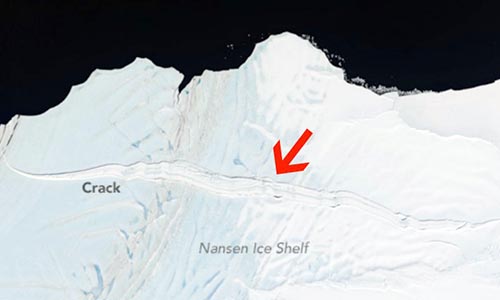
Ice Shelf Twice the Size of Manhattan Is About to Break Off From Antarctica

“Even in winter, strong winds can prevent the water beyond the shelf from freezing, so it is unclear whether the front will separate soon or hang on like a loose tooth,” NASA said.
Although the ice shelf’s collapse may sound catastrophic, IFLScience noted, there are two points worth considering:
“Firstly, ice shelves make up around 75 percent of the Antarctic coastline, and their total combined area is equivalent to 1.56 million square kilometers (603,000 square miles). If all of Nansen collapses, it will reduce Antarctica’s ice shelf coverage by just 0.1 percent.
Nansen doesn’t even register as a ‘major’ ice shelf, with those such as Ross, at around 472,000 square kilometers (182,000 square miles), dwarfing it. The Ross Ice Shelf partly collapsed at the end of the last ice age around 10,000 years ago, when a colossal chunk 280,000 square kilometers (108,000 square miles) in size fell into the sea over 1,500 years. That’s 360 times the size of Manhattan Island, by the way.
Secondly, these ice shelves may be anchored to the land, but they do not actually significantly contribute to sea level rise—after all, they’re already floating on the sea. So the collapse of Nansen by itself won’t cause much harm, per se.
However, ice shelves like Nansen do act as vast barricades for glaciers behind them. When an ice shelf is removed, glaciers begin to tumble into the sea at surprisingly fast speeds—sometimes moving ten times faster than normal—and these will definitely cause the sea level to rise. So in effect, man-made climate change is breaking Antarctica’s huge ice dams.
And while ice shelves have historically broken off and often reformed, ScienceAlert said the trend is alarming:
“Several iconic ice-shelf disintegrations, such as the Serson Ice Shelf in northern Canada, have been linked to increasing temperatures.
And the rate of ice shelf loss has also been speeding up. Over the past 20 years, Antarctica’s Larsen ice shelves has pretty much decreased significantly, losing 75 percent of its area.
The icebergs produced by these types of events don’t just pose threats to boats that get in their way, but also to marine life—such as the 150,000 penguins that died at the start of this year when an iceberg blocked their path to the sea, cutting off their food supply.”
NASA researchers want to keep studying the ice shelves to better understand why they collapse and how to prevent it. Dow is already planning a trip with other researchers to study the crack this summer.
“I’m really interested to see whether this feature is occurring because of the topography around the ice shelf, or whether it was initially created by surface water flowing into a small ice surface crack,” she said. “We’re planning an intensive survey of this feature in the coming years and will hopefully get a handle on the causes.”
YOU MIGHT ALSO LIKE
13 Million Americans at Risk From Rising Seas
February Smashes Earth’s All-Time Global Heat Record by a Jaw-Dropping Margin
NOAA: Carbon Dioxide Levels ‘Exploded’ in 2015, Highest Seen Since End of Ice Age
Obama, Trudeau Agree to Safeguarding Arctic, Reducing Methane Emissions

 233k
233k  41k
41k  Subscribe
Subscribe 